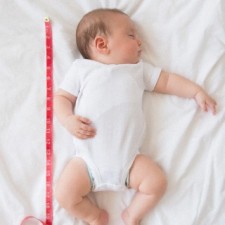
TEL AVIV (Press Release) — After their hectic experience of delivery, newborns are almost immediately stretched out on a measuring board to assess their length. Medical staff, reluctant to cause infants discomfort, are tasked with measuring their length, because it serves as an indispensable marker of growth, health and development. But the inaccuracy and unreliability of current measurement methods restrict their use, so routine measurements are often not performed.
Now Tel Aviv University researchers have taken a 21st century approach to the problem, using new software that harnesses computer vision to more accurately measure infant length. The technique, which is much easier on infants and at least as accurate as conventional measuring methods, was developed by a research team led by Prof. Lea Sirota, of TAU’s Sackler Faculty of Medicine and head of the Neonatal Intensive Care Unit at Schneider Children’s Medical Center, and Prof. Moshe Philip, a vice dean at TAU’s Sackler Faculty of Medicine and head of the Institute for Endocrinology and Diabetes at Schneider Children’s Medical Center, together with Dr. Nir Sokolover of TAU’s Sackler Faculty of Medicine and Schneider Children’s Medical Center, and Prof. Nahum Kiryati and Ms. Amalia Potruch of TAU’s School of Engineering.
Results of a clinical trial of the new stereoscopic measurement system were published in Archives of Disease in Childhood.
“The need to forcibly extend the infants against their will leads to unreliability and inaccuracy of the measurement, and staff members are understandably reluctant to do it,” said Dr. Sokolover. “We wanted to develop an accurate, reliable, and practical tool for infant length measurement to facilitate evaluation and follow-up of growth without exposing newborns to a cold environment, infection, or discomfort.”|
In the study, 54 newborns, roughly half male and half female, were measured using the stereoscopic vision system. Two digital cameras connected and operated by a computer took photographs of each infant. Technology developed by the research team later calculated the infants’ length by summing up four body segments from the heel to the crown. Most importantly perhaps, infants could be photographed while lying naturally on their backs, with no need to physically restrict them in a certain position.
In terms of accuracy, the study recorded negligibly different results than those of meticulously performed standard measurements, with a mean average difference of only 0.2 millimeters. According to Dr. Sokolover, the stereoscopic system does not reflect light or radiation on the measured infants, and is therefore considered safe.
“I am a neonatologist who works daily in a neonatal intensive care unit, so I have experienced first-hand the difficulties of the standard measuring practice,” said Dr. Sokolover. “The new system has the potential to improve compliance with routine health and development surveillance measurements, and thereby improve public health.”
The team is currently observing the impact of the new system on neonatal intensive care units, where premature and sick infants unable to leave their incubators cannot be measured with the standard stretching practice.
“We are now testing a new and improved prototype of our system and clinically validating its ability to measure through incubators,” said Dr. Sokolover. “We are encouraged by the results so far and by positive feedback from both local and international colleagues.”
*
Preceding provided by Tel Aviv University